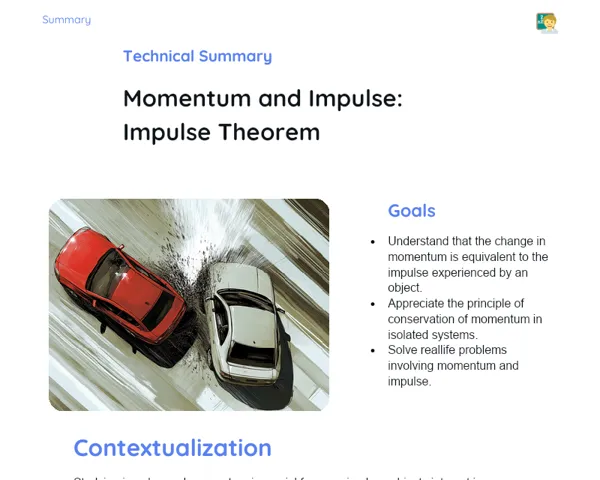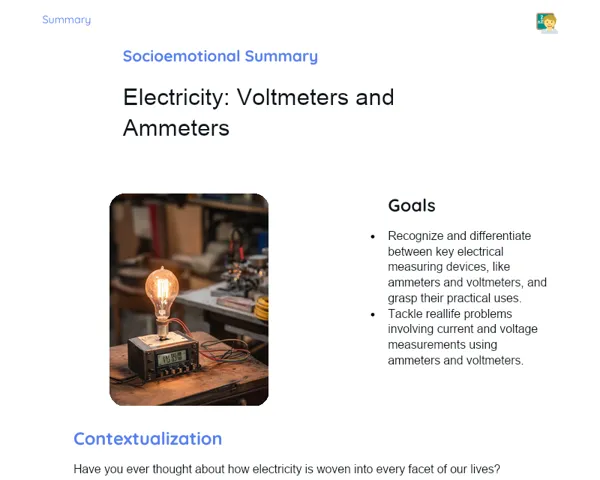Summary Tradisional | Kinematics: Uniformly Accelerated Motion Graphs
Contextualization
Kinematics is a fascinating branch of Physics that delves into how things move without getting tangled up in the reasons behind that motion. One key area here is uniformly accelerated motion (UAM), where the acceleration remains consistent. This means that an object's speed changes steadily over time. To effectively grasp how different objects move in various scenarios, it's vital to understand the graphs that depict UAM.
These graphs serve as critical visual aids that highlight the relationships between speed, position, and acceleration as time passes. For instance, the speed versus time graph (v x t) for UAM appears as a straight line that slopes upwards, signaling constant acceleration. On the other hand, the position versus time graph (s x t) takes the shape of a parabola, with its concavity indicating the direction of the acceleration. Mastering these graphs empowers students to tackle practical problems, such as finding out how quickly a car is accelerating or analyzing the path of a freely falling object.
To Remember!
Speed vs. Time Graph (v x t)
The speed versus time graph (v x t) is an essential resource for understanding uniformly accelerated motion. In this chart, speed is plotted on the vertical axis (y-axis), while time is plotted along the horizontal axis (x-axis). For uniformly accelerated motion, the constant acceleration leads to an inclined straight line on the v x t graph. The steepness of this line reflects the object's acceleration. If the line rises, we have positive acceleration, meaning the object's speed is increasing. Conversely, if the line tilts downward, that's negative acceleration, indicating the object is slowing down. The area underneath the line in the v x t graph shows how far the object has travelled in the given time.
-
The slope of the line on the v x t graph shows the acceleration.
-
A line that slopes upwards means positive acceleration.
-
A line that slopes downwards indicates deceleration.
-
The area beneath the line highlights the change in the object's position.
Position vs. Time Graph (s x t)
The position versus time graph (s x t) is another crucial tool for analyzing uniformly accelerated motion. Here, the object's position is plotted on the vertical axis (y-axis) and time on the horizontal (x-axis). The s x t graph takes the form of a parabola. Whether the parabola opens upwards or downwards indicates the nature of the acceleration. An upwards concave parabola represents positive acceleration, while a downwards opening parabola indicates negative acceleration. The initial position and speed of the object dictate where the parabola sits on the graph. This graph is especially useful in visualizing how the object's position changes over time and figuring out the acceleration based on the curve's shape.
-
The s x t graph for uniformly accelerated motion is a parabola.
-
An upward-facing concavity signifies positive acceleration.
-
A downward-facing concavity shows negative acceleration.
-
The initial position and speed of the object shape the parabola's location on the graph.
Acceleration vs. Time Graph (a x t)
The acceleration versus time graph (a x t) illustrates how an object's acceleration changes over time. In this graph, acceleration appears on the vertical axis (y-axis) and time on the horizontal (x-axis). For uniformly accelerated motion, the acceleration remains steady, resulting in a straight line parallel to the time axis on the a x t graph. If this line resides above the horizontal axis, we see positive acceleration, while a position below indicates negative acceleration. This graph is particularly useful for visualizing and confirming that the acceleration stays consistent over time, a hallmark of uniformly accelerated motion. The line's placement relative to the horizontal axis also conveys information about the direction of the acceleration.
-
The a x t graph for uniformly accelerated motion is a straight line parallel to the time axis.
-
A line situated above the horizontal axis indicates positive acceleration.
-
A line below the horizontal axis signifies negative acceleration.
-
This graph reaffirms that the acceleration is steady over time.
Problem Solving with Uniformly Accelerated Motion Graphs
Being able to solve problems using uniformly accelerated motion graphs is a crucial skill for physics students. These graphs offer a visual summary that aids in deciphering and tackling intricate problems. For example, from a v x t graph, students can ascertain the object's acceleration by calculating the slope of the straight line. Similarly, they can find the total distance travelled by determining the area beneath this line. In the s x t graph, the curve's shape can reveal acceleration, while the starting position and speed can be drawn from the initial points plotted. Practicing problem-solving with these graphs helps students deepen their understanding and apply theoretical concepts to real-world scenarios.
-
Graphs of uniformly accelerated motion assist in solving complex problems.
-
The slope of the line on the v x t graph reveals the acceleration.
-
The area below the line on the v x t graph signifies the distance travelled.
-
The curvature of the parabola on the s x t graph indicates acceleration.
Key Terms
-
Kinematics: The study of how bodies move without focusing on the reasons behind their motion.
-
Uniformly Accelerated Motion (UAM): Motion defined by constant acceleration.
-
Speed vs. Time Graph (v x t): A visual representation showcasing the object's speed over time.
-
Position vs. Time Graph (s x t): A visual representation displaying the object's position as time progresses.
-
Acceleration vs. Time Graph (a x t): A visual representation highlighting the object's acceleration with respect to time.
-
Acceleration: The rate at which speed changes over time.
-
Deceleration: The act of slowing down an object's speed over time.
Important Conclusions
In this lesson, we explored the graphs of uniformly accelerated motion (UAM), which is a foundational concept in kinematics. We covered how to interpret the speed versus time graph (v x t), position versus time graph (s x t), and acceleration versus time graph (a x t), recognizing how each represents distinct aspects of an object's motion under constant acceleration. These graphs are invaluable for visualizing and analyzing motion, helping us determine key parameters like acceleration, initial speed, and distance travelled.
Grasping the UAM graphs is crucial for resolving practical physics problems, such as calculating how fast a car is accelerating or the path of an object in free fall. Being skilled in interpreting and utilizing these graphs strengthens theoretical knowledge and translates it to real-life applications, from creating stunning visual effects in films to devising efficient braking systems in vehicles. Regular practice in tackling problems with these graphs is vital for mastery.
Finally, understanding UAM graphs extends beyond academic settings, as they have substantial practical implications in various aspects of everyday life and technology. I urge everyone to keep delving into this topic, experimenting, and working on diverse problems to enhance their knowledge and skills in kinematics.
Study Tips
-
Revise the basic principles of kinematics and uniformly accelerated motion, ensuring you have a clear grasp of definitions and fundamental formulas.
-
Practice solving problems with different types of graphs (v x t, s x t, a x t), concentrating on identifying and calculating acceleration, initial speed, and distance travelled.
-
Explore supplementary resources, like educational videos and interactive online simulators, to visualize motion and graphs, reinforcing theoretical lessons with practical examples.



